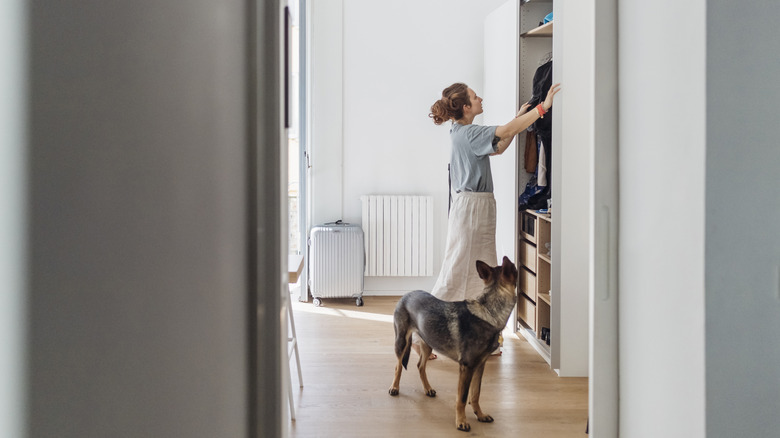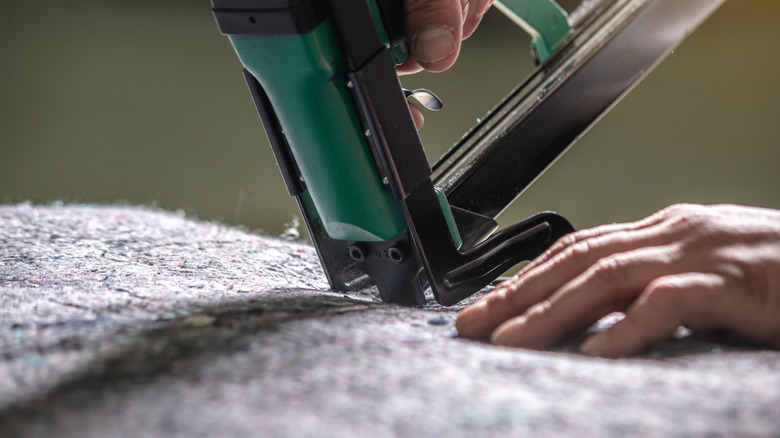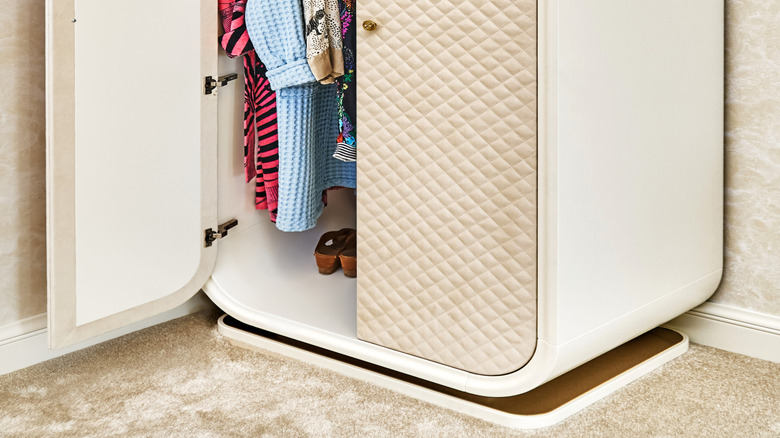Upgrade Boring Closet Doors With A Showstopping Design Idea You Never Thought Of
We may receive a commission on purchases made from links.
When the mood for a bedroom makeover strikes, don't overlook a closet door's potential to deliver an impactful design statement. While some may take the classic route of painting a closet door to turn it into an eye-catching statement piece, an upholstered one adds a luxurious and tactile dimension to your bedroom's overall look. With a wide variety of fabric patterns, colors, and textures to choose from, you can transform a bland closet door to fit a modern, country, or bohemian aesthetic — really, the choices are endless. Matching your fabric to your room's existing textiles — bedding, curtains, or throws — creates a cohesive color palette that effortlessly pulls a room together.
Work with a professional upholsterer to get the sleek, crisp look you're dreaming of, or give it a try and DIY upholstered closet doors yourself. There are a number of ways to go about this project, from simply adhering a piece of fabric to your existing closet doors to building new customized closet doors from scratch, or even going the extra mile by using quilting batting to create a padded closet door. Whatever path you choose, make sure to pick out a fabric you love, and consider how its patterns or colors will hold up over time. Before starting on this upholstery journey, make an assessment of any quirks your closet door may present. Are there large gaps at the bottom, or does the door barely clear the floor? Does it stick to the door frame, or are there any apparent misalignment issues? This will help you decide whether to include or exclude your door's edges in this upholstery project, and whether it's possible to DIY or you'll need some professional assistance.
Covering flat-surface closet doors with fabric
The easiest way to a stunning fabric-covered closet door is by covering only the front surface with fabric, and not its sides. We strongly suggest this method only for flat-surfaced swing-out closet doors, as fabric can cause friction against a sliding closet's mechanisms. Start by removing your door's hardware and detaching the door from its hinges. Measure and cut out your fabric according to your door's surface, allotting one to two inches all around to create a hem for neater edges. Line the edges of the fabric to the door's front edges and use a staple gun to staple at regular intervals. If your closet door has moldings, consider adding fabric to the inner panels of the moldings as a way to highlight your door's details.
To add a decorative element that simultaneously hides the staples from view, add a nail-head trim like Let's Decorate Brass Plated Decorative Nail Strips or use nail tacks like House2Home Upholstery Tacks. Alternatively, apply a creative hack used to upgrade outdated curtains: Add a decorative fabric trim around the edges, or use ribbon fabric tape trim like the Yuuzue Jacquard Ribbon Fabric Trim. Reattach the door's hardware and place it back on its frame to admire its new look.
Add batting for a padded feel, or build your own closet door
You may want to secure the fabric to the back of your closet door for an even stronger hold, and this can be done by measuring out enough length to go around the door's edges. As with choosing upholstery, you can even add batting to create a padded look that will give your closet door more depth and texture. Pick up enough rolls of quilt batting like the PLANTIONAL Natural Cotton Batting to use as a layer beneath the fabric, stapling it to the door's surface. When using batting, remember to stop short of the door edges to ensure the doors can close without friction. With the batting firmly in place, cover the door with your fabric, snugly pull the excess around the edges and staple to the back of the closet door.
Want to start from scratch? Consider building your own closet doors to replace outdated ones. Start by building frame panels according to your closet door measurements, marking the positions for the necessary hardware and hinges that are needed to attach them to the frame. Use 2x2 wood for your door frame, selecting straight pieces. If you aren't tackling the project straight away, allow the wood to acclimate indoors. Add horizontal wood reinforcements on the upper and lower thirds of your frame for a sturdier body. Then, following the upholstering steps above, wrap the frame with batting, fabric, or both, depending on your desired look.


